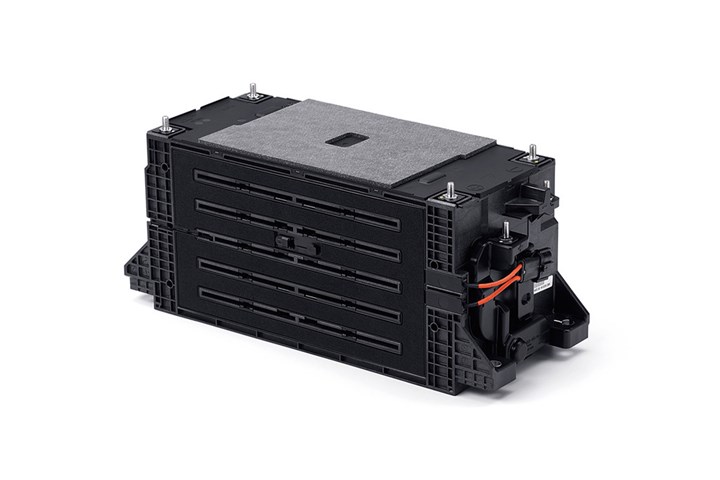Lanxess, INFAC develop composite battery module housing
The halogen-free, flame-retardant and glass fiber-reinforced polyamide 6 (PA6) part lowers battery module assembly weight, improves insulation and flame resistance and retains a high level of functional integration.

Lanxess and INFAC have together developed a battery module housing for electric vehicles (EVs). The battery housing has been adopted to series production of EV models launched by a Korean OEM. Photo Credit: INFAC
Specialty chemicals company Lanxess (Cologne, Germany) and Korean auto parts specialist INFAC (Seoul), which specializes in automotive control cables, actuators, antennas, and battery packs, have together developed a battery module housing for electric vehicles (EVs).
The battery housing uses Durethan BKV30FN04 from Lanxess to satisfy stringent mechanical and chemical property requirements for latest EV components. The halogen-free, flame-retardant and glass fiber-reinforced polyamide 6 (PA6) is characterized by its optimized flame-retardant and electrical properties. Lanxess notes that the material is highly processable and enables the integration of complex functions required for housing components, resulting in a smaller number of parts and a simplified assembly process as well as lighter weight.
Moreover, the new battery housing part has been adopted to series production of EV models launched by a Korean OEM this year. “Success in mass production of battery housing demonstrates Lanxess Durethan’s excellence in EV batteries, in which technology and safety are of utmost importance. Our high-performance plastics will make a significant contribution to the EV and battery markets,” says Milan Vignjevic, head of Lanxess’ High Performance Materials (HPM) business unit in Asia-Pacific.
According to Lanxess, Durethan BKV30FN04 is not only mechanically robust, but also boasts high-voltage insulation, is resistant to up to 800 volts and effectively blocking high-voltage current, characteristics that are critical in order to protect the battery from external shock. In addition to maintaining high strength and stiffness when in contact with electrolyte or cooling media, and enabling chemical resistance to suppress chemically-induced damage, the material’s flame-retardant properties help prevent or delay flames from spreading in case of a fire. Lanxess claims glass fiber-reinforced Durethan BKV30FN04’s durability to mechanical loads is also superior to unfilled PA6.
Lanxess’ engineering plastics can reportedly be applied to a wide range of battery components including battery covers, high-voltage connectors, cable brackets and battery cell cooling system pipes as well as parts for hydrogen fuel cell vehicles such as hydrogen storage tanks. It can also replace metals in various components, enabling lightweight design. Overall, it allows the production of several functional components in one process, a driver behind continuous growth in demand in the next-generation mobility market where a number of technologies and components come into play.
“High-quality materials, technical expertise and customized engineering services from Lanxess enabled us to speed up our development. This helped solidify our position in the fast-evolving EV battery parts market,” says Gyuso Lee, head of Purchasing & Development at INFAC.
Sanghun Han, head of HPM in Korea, adds that Lanxess has closely cooperated with globally leading automotive OEMs, including from Korea. “That is why we were able to identify the trends and the challenges of e-mobility at an early stage and participate in various EV and battery development projects,” Han says. “With accumulated success stories with our customers, we are establishing ourselves as a key material partner in new mobility.”
Related Content
-
Bioabsorbable and degradable glass fibers, compostable composite parts
ABM Composite offers sustainable options and up to a 60% reduction in carbon footprint for glass fiber-reinforced composites.
-
Composite wrap system combats corrosion in industrial tank repair
A fiberglass and carbon fiber composite wrap system enabled an Australian nickel mine to quickly repair a stainless steel ammonium sulphate feed tank and protect against future corrosion.
-
Running shoe insoles get a lift with thermoplastic fiberglass tapes
FlexSpring insoles take advantage of unidirectional, continuous fiberglass and thermoplastics to enable next-level performance for the everyday runner.















